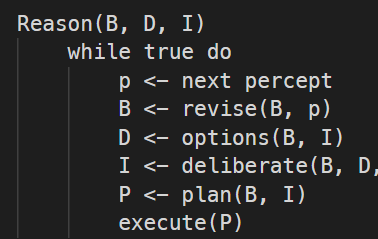Belief, Desire, Intention
Implementations
Simplified BDI Algorithm

Resources
-
https://academic.oup.com/mind/advance-article-abstract/doi/10.1093/mind/fzac047/6765183
- "A traditional Humean view about motivation says that only desires motivate action. This theory meshes with the familiar ‘directions of fit’ metaphor: while beliefs aim to fit the world, desires aim to change it. In this way, desires and beliefs appear to be different types of mental state. But such appearances may be misleading. The central aim of Alex Gregory’s Desire as Belief is to defend the unorthodox thesis that desires (or equivalently, wants) are nothing more than beliefs with a particular normative content, an idea with Aristotelian and Stoic roots (see p. 20). In particular, the proposal is that to desire something amounts to believing that you have a reason to bring it about. It is beliefs of this sort, combined with instrumental beliefs, that explain motivation. Gregory’s book is a consistently impressive defence of what he calls desire-as-belief.
Chapter 1 clarifies desire-as-belief by way of an analogy with the mental state of disbelieving. To talk of disbelief, on a straightforward analysis, is to talk jointly of an attitude and a content. That is, disbelieving that p doesn’t seem to refer to a sui generis attitude of disbelieving but rather a belief, namely a belief that not-p. In similar fashion, desire-as-belief says that my desiring that p consists of an attitude – belief – with a certain content – that I have a reason to bring about p. Such first-personal beliefs about reasons are special in that they have both aforementioned directions of fit. They aim to conform to the world insofar as they are correct just in case the belief is true; and they aim to change it insofar as such beliefs dispose the desirer to act according to the relevant reasons."
References
Children
Backlinks